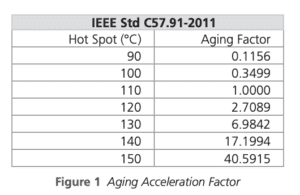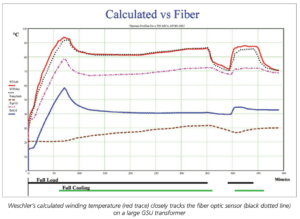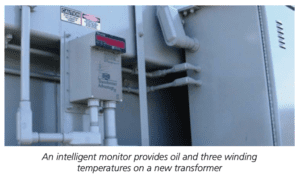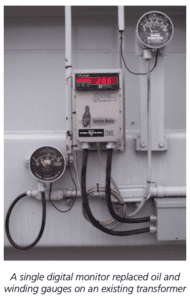Average loading on transformers is increasing as utilities strive for higher asset utilization. Higher loads mean hotter operation and the need for improved thermal management. Intelligent transformer monitors, such as the Weschler Transformer Advantage, provide users with reliable thermal data and flexible cooling control.
 Poor temperature control will reduce the life of oil-filled transmission, distribution and generation transformers. The IEEE Guide for Loading Mineral-Oil-Filled Transformers shows that the transformer aging factor for thermally upgraded paper increases dramatically at hot spot temperatures above 120°C (see Figure 1). Even at 117°C, the aging rate is twice that at 110°C.
Poor temperature control will reduce the life of oil-filled transmission, distribution and generation transformers. The IEEE Guide for Loading Mineral-Oil-Filled Transformers shows that the transformer aging factor for thermally upgraded paper increases dramatically at hot spot temperatures above 120°C (see Figure 1). Even at 117°C, the aging rate is twice that at 110°C.
To manage transformer temperatures, an intelligent transformer monitor must provide multi-stage cooling control based on oil and winding temperatures. The Weschler Transformer Advantage handles up to 6 cooling stages plus redundant stages. In addition to oil and winding temperatures, cooling can be activated based on winding current, ambient temperature, time of day, season or remote command. With this flexibility, a utility can implement a strategy suitable for each site’s operating conditions. For example, first stage cooling can be initiated based on a load increase, without waiting for the tank or winding temperature to reach a setpoint value. Another common choice is to set the first stage cooling to run continuously during the summer months. Conversely, cooling can be reduced at night to comply with local noise ordinances.
Efficient Cooling Stage Operation
Fan cooling stages are typically set to run in fail-safe mode. In addition to activation above the setpoint, these stages should be activated in the event of a control or power source failure. This provides further protection of the critical transformer asset. Each Transformer Advantage comes with 24 alarms and up to 12 form C (changeover) relays. Multiple alarms can be configured to drive a relay (e.g. oil temperature >70°C or winding temperature >85°C or winding current >500A). Each relay can be individually set up for normal or fail-safe operation. Programmable operate/release delays avoid nuisance trips or electrical/pressure surges due to simultaneous activation of multiple cooling stages. These delays can also be used to prevent rapid fan or pump cycling.
Four-wire Platinum RTDs (resistance temperature detectors) are the preferred sensor for electronic transformer monitors. They provide accurate, stable temperature measurements and are insensitive to lead length. The Type A probes supplied with the Advantage has an initial accuracy better than 0.5°C and drift of <0.2°C/year. Digital computations with automatic self-checks inside the Advantage assure displayed values are accurate years hence. A watchdog relay will report an internal problem, so there are no silent failures – as are often encountered with analog (bourdon tube) temperature gauges.
Efficient cooling stage operation is critical to managing transformer temperature. One Transformer Advantage option is a cooling stage read-back to verify proper fan/pump operation and alarm if field service is required. This feature also assures that the correct transformer profile (ON/OF/OD) is used for all winding temperature calculations.
The Loss of Life (insulation aging) option keeps a running tally of the remaining transformer life based on the time/temperature profile of operation to date and the IEEE aging table. Users can also see the present aging rate (hours of life consumed for each hour of operation at the present winding temperature).
Intelligent Transformer Monitor
Another useful function of an intelligent transformer monitor is to act as a data concentrator. Isolated analog/digital inputs allow the Transformer Advantage to read other devices on the transformer and report their status to the substation network. This is particularly useful for legacy gauges that lack a digital interface. Typical examples include oil level, pressure switch, tap position, LTC position. Signals from logic level to 300V AC/DC, 0-1 or 4-20mA, and either wet or dry switch contacts can be accommodated.
 Winding Temperature Indication
Winding Temperature Indication
Two popular methods for winding temperature indication are the simulated winding technique and calculated winding technique. Simulated winding uses the same heated thermowell an analog indicator but replaces the gas bulb sensor with an RTD and digital meter. This is the easiest way to upgrade an existing transformer to an electronic monitor. Calculated winding combines a top oil temperature measurement, winding current measurement and transformer parameters entered at setup to obtain a winding temperature value using the method defined in IEEE C57.91. Weschler adds proprietary enhancements for transient conditions. In a side-by-side comparison to an embedded fiber sensor, the Transformer Advantage closely tracked the fiber sensor in both steady-state and transient conditions. The calculated winding technique is recommended for new transformers and existing transformers with heat run data. Weschler offers three models for each method in the Transformer Advantage family.
 Configuration and monitoring software facilitates setup & support of an intelligent monitor. The Weschler unit is supplied with a walkup interface port and a comprehensive Windows-based software package. The monitor program shows the status of all channels, alarms and relays. It also expedites the review of stored data and export of that information to Excel for further analysis or archiving. The configuration program allows users to enter or modify settings. Weschler will also provide free setup of units at the factory, on request.
Configuration and monitoring software facilitates setup & support of an intelligent monitor. The Weschler unit is supplied with a walkup interface port and a comprehensive Windows-based software package. The monitor program shows the status of all channels, alarms and relays. It also expedites the review of stored data and export of that information to Excel for further analysis or archiving. The configuration program allows users to enter or modify settings. Weschler will also provide free setup of units at the factory, on request.
 Third Generation Monitor
Third Generation Monitor
The Transformer Advantage is Weschler’s third-generation monitor. Field reliability has been demonstrated by the thousands of units in daily use worldwide since 2005. For mechanical ruggedness, the Advantage has a heavy aluminum housing, which is sealed to IP66. The RTD temperature probes are stainless steel with a stainless steel braid on the cable. Extensive transient, surge and ESD protection are integral to the design. Installation is straightforward for either the simulated winding temperature (heated thermowell) models or the calculated winding temperature models. Units can be specified for single or three winding temperatures. Other configuration options include a number of inputs, probe size, power supply range, communication interface, protocol, auxiliary inputs, and analog outputs. LTC temperature monitoring is also available.
Conclusion
Intelligent temperature monitoring/control will extend transformer life and improve system reliability while allowing higher loading. Models are available for easy installation on new or existing transformers. These units can be ordered and configured to fit a wide variety of field requirements.
